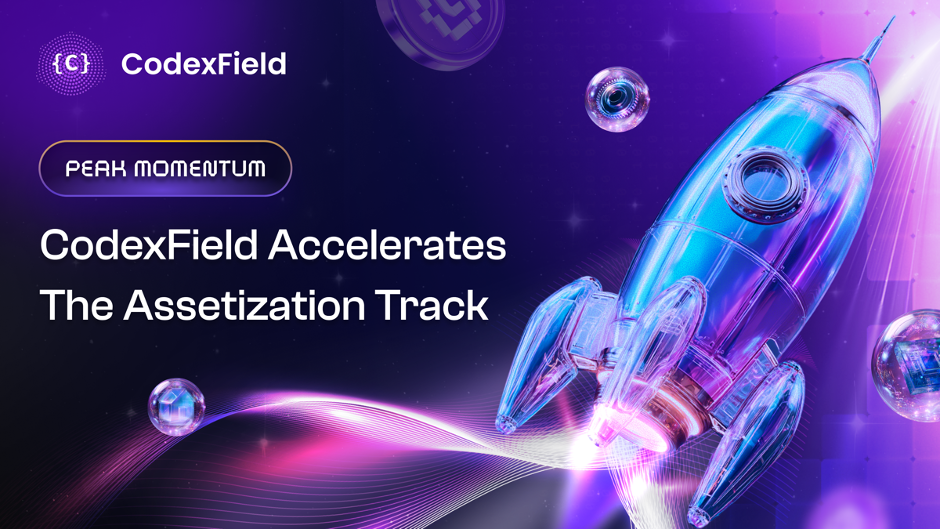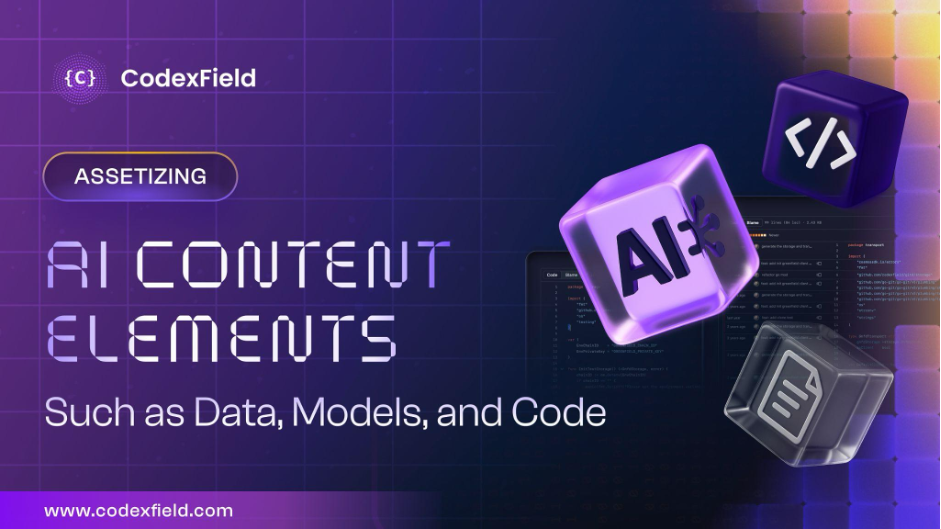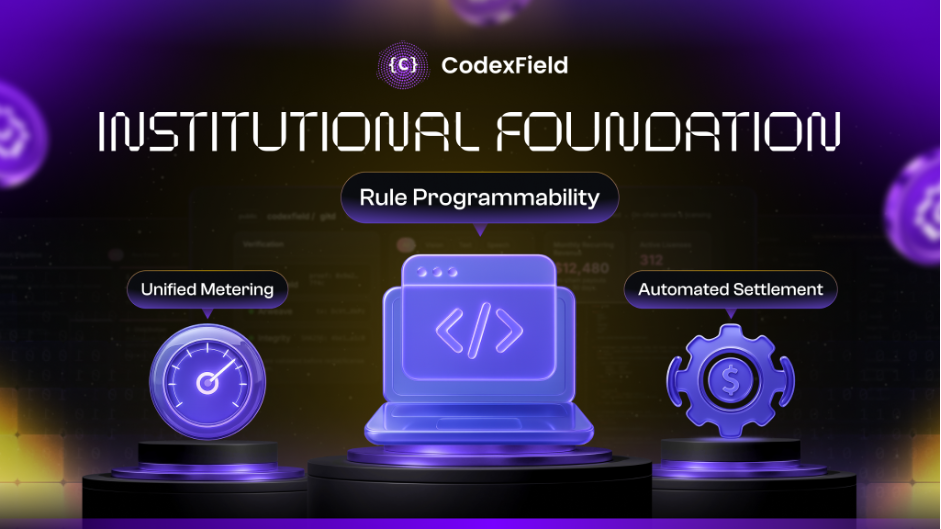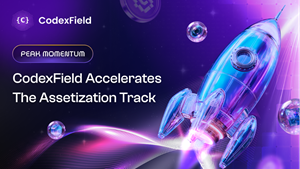CodexField Officially Announces Its RWA Framework: Turning Content into Verifiable, Measurable, and Rewardable Real-World Assets

SINGAPORE, Oct. 14, 2025 (GLOBE NEWSWIRE) -- CodexField officially announced the launch of its Real-World Asset (RWA) framework for digital content and AI models — a groundbreaking initiative designed to transform creative output into verifiable, measurable, and rewardable on-chain assets. As the global content economy and generative AI industry enter a new phase of exponential growth, CodexField’s new RWA narrative introduces a Web3-native asset infrastructure that allows content, models, and algorithms to achieve transparent rights confirmation, measurable usage, and automated profit-sharing through blockchain technology.
Content is Exploding, but the Value System Lags Behind
The production of global content and models is expanding at an exponential rate. According to IDC data, the global datasphere is expected to reach 181 Zettabytes by the end of 2025, more than three times that of 2020. Simultaneously, the proliferation of generative AI has lowered the barrier to content creation to a historical low. Open APIs from model platforms like OpenAI, Anthropic, and Mistral enable text, image, audio, and code generation capabilities to be invoked across hundreds of millions of endpoints, forming an unprecedented "flood of content production." In this process, the boundaries between content, models, and algorithms continue to blur, but the value distribution and rights confirmation systems have not evolved accordingly.
In fact, the existing Web2 model remains platform-centric. The text, videos, or algorithm models produced by creators ultimately reside within the closed databases of large content or technology platforms. Platforms control the data, algorithms, and the dominant share of revenue distribution, while individuals receive only limited exposure or usage-based payouts.
From a revenue perspective, approximately 72% of the global digital content market's earnings are concentrated within less than 5% of platform ecosystems, while the revenue share for original creators or developers has long remained in the single digits. This centralized structure weakens innovation incentives and keeps the logic of "content as asset" stuck at the theoretical level.
Meanwhile, the rapid evolution of AI models further exacerbates this "value disconnect." Model training relies on massive amounts of content and data, yet the contributors behind this data receive almost no rights confirmation or revenue reflow. For instance, Stability AI publicly admitted in 2023 that its Stable Diffusion model training data included billions of unauthorized images, highlighting the structural asymmetry between "content supply" and "model income." When content becomes fuel for AI, its economic value is absorbed by the algorithms but is difficult to measure and return within the system.
RWA Emerges as a New Direction of Exploration
We see this dilemma giving rise to new explorations into how content and models can possess the attributes of assets – confirmable, measurable, and rewardable.
The traditional RWA narrative focuses on the tokenization of bonds, real estate, and income certificates on-chain to enhance the liquidity and transparency of financial assets. At the intersection of AI and the content economy, the connotation of RWA is expanding, extending from physical assets to digital production factors. Digital works, training corpora, algorithm code, and even model invocation rights are being redefined as "new asset units" that are confirmable, tradable, and profit-shareable.
There are already signs of this trend at the capital and regulatory levels. Deloitte's 2024 "Digital Asset Outlook" report indicates that by 2030, approximately 15% of the global RWA market will consist of digital content, intellectual property, and data assets, with a total scale reaching $3.2 trillion. This means that "content assetization" is moving from the conceptual stage to the stage of institutional construction.
Against this backdrop, the industry urgently needs a set of underlying infrastructure that can enable content, models, and algorithms to be rights-confirmed in a trustworthy manner, measured through transparent mechanisms, and have revenues distributed across applications and entities. CodexField emerges at this historical turning point, attempting to bridge the gap between content assetization and institutionalization through a technological path.
CodexField's RWA Narrative
Amid the trend of reshaping the content value chain, CodexField is attempting to establish a Web3-native asset infrastructure for creators and developers, aiming to enable structured content to be confirmable, callable, and financializable. The project focuses on highly reusable content units such as code, models, prompts, corpora, and graphics/text, proposing a unified standard for data encapsulation and authorized invocation. This allows such content to be rights-confirmed on-chain, tracked, and have revenues mapped via smart contracts, thereby advancing the standardization process of "content as asset."
The CodexField architecture covers the entire process of content from storage and authorization to billing and profit-sharing. The system is compatible with multi-chain ecosystems like BSC, Ethereum, Solana, Greenfield, and mainstream storage networks. It supports the definition of content access and commercial use policies via smart contracts, enabling on-chain automatic settlement and distribution for behaviors like content invocation, subscriptions, and model training. This mechanism allows creators and collaborators to directly participate in the revenue path, ensuring traceability of data usage and transparency in profit-sharing.
As a key middleware layer in the content assetization path, CodexField not only targets independent creators and AI model developers but also provides platform operators with standardized "Content-as-a-Service" interfaces, facilitating the flow and composition of content assets between Web3 and AI ecosystems. Its goal is to build a transparent, verifiable, and financially-enabled content economic protocol on top of the existing fragmented content system, providing foundational support for the future "Measurable Content Economy."

Technological Innovation and Implementation Path
CodexField's system architecture is built on a clear hypothesis: for content to truly possess asset attributes, it must have technical verifiability and economic measurability across the three stages of rights confirmation, invocation, and settlement. This logic is more of a cross-layer systematic engineering design, unifying Web3's asset registration logic, AI's invocation tracking mechanisms, and traditional finance's accounting mindset into a closed-loop technological path.
Structured Mapping from Content to Asset
CodexField uses the "Content Capsule" as its core data structure, performing structured encapsulation of various creative units like text, images, model weights, corpora, prompts, and code modules. Each capsule is generated with a unique asset ID and records creator identity, version information, reference relationships, and timestamps, thereby forming an atomic asset unit on the chain with independent rights confirmation capability.
This structure is not merely a hash registration; it is more of a "computable rights confirmation" system, allowing assets to be partially invoked, incrementally updated, and reference-composed.
For example, a model might only invoke part of a dataset's corpus or reference a specific fragment of another's algorithm. The system automatically traces the dependency path during invocation and generates corresponding reference weights. This shifts content rights confirmation away from relying on full attribution towards finer-grained structured annotation, which is the technical prerequisite for "content financialization."
Programmable and Verifiable Licensing
In traditional content ecosystems, authorization often relies on contracts and manual review, lacking a verifiable execution basis. CodexField achieves standardization and programmability of authorization relationships through LexDL and CapToken.
LexDL is a human-readable, machine-executable license language that can describe conditions such as access scope, geographical restrictions, usage types, and time dimensions. Based on this, the system generates CapToken – an access credential bound to authorization rules. Each content invocation or model training requires the corresponding CapToken to pass contract verification, and automatically writes a usage receipt after execution. This approach turns "authorization" from a paper clause into a necessary prerequisite for technical execution, safeguarding creators' revenue boundaries while enabling enterprises or platforms to achieve automated compliance management.
Notably, this mechanism is particularly critical in multi-party collaboration environments: AI model training often involves different data sources and algorithm contributors, making it difficult to define rights and interests traditionally. The permission structure based on LexDL + CapToken can replace "human judgment" with "machine trust," providing an institutional foundation for future cross-institutional training and data collaboration.
Generation of Verifiable Economic Events
The value of content and models within the CodexField system is quantitatively measured primarily through the objective behavior of "use." The system generates a verifiable record for each real invocation, called the Usage Receipt.
Each receipt contains key task information: invoking role, invoked content, duration, execution efficiency, and resource consumption. It acts as a digital voucher for an economic event, capable of being tracked and calculated in real-time by the on-chain system. Thus, the value of content no longer depends on platform pricing or traffic direction but is automatically measured based on the frequency and depth of its use.
These receipts collectively constitute CodexField's "Value Ledger Layer." When content or a model is used, the system calculates revenue distribution based on invocation data and directly sends profit shares to relevant creators, collaborators, and data providers via smart contracts. The entire process is transparent, auditable, and requires no centralized platform participation.
In more complex scenarios, such as a model referencing multiple algorithms, datasets, or scripts, CodexField tracks reference relationships through a "Royalty Graph," automatically breaking down the revenue proportions. This graph records inheritance and derivative relationships between content. When a node is used, the system can accurately distribute rewards along the path to all contributors.
This mechanism elevates content profit-sharing from the level of contract signing or platform rules to an economically "protocol-executed" behavior. Each invocation, each training session, each collaboration leaves a clear value trail on the chain. Ultimately, CodexField endows content production and model training – originally vague value flows – with the same measurability and credibility as financial assets. This is a key step in propelling "content assetization" from concept to institutionalization.

Computational Trust and Cross-Domain Consistency
CodexField's execution system is built on a multi-layer verification architecture, with the core goal of balancing efficiency, trustworthiness, and scalability.
In lightweight task scenarios, such as content retrieval or model invocation, the system generates verifiable results using Zero-Knowledge Proofs, allowing external nodes to confirm execution authenticity without exposing data details. For large-scale model inference or training tasks, CodexField adopts a Trusted Execution Environment combined with a committee verification mechanism, maintaining computational performance while ensuring security.
This design enables CodexField to flexibly schedule resources for tasks of varying intensity and sensitivity, while keeping the system's computational results verifiable and reviewable. For developers needing to share computing power across different institutions or regions, this architecture significantly reduces trust costs and enhances overall execution reliability.
To further ensure smooth cross-chain collaboration, CodexField also introduces a "Dual-Bridge Mechanism."
The "Receipt Bridge" is responsible for synchronizing execution results and settlement data, while the "Mirror Bridge" synchronizes asset states and authorization permissions. This layered structure maintains consistency of data and state across different networks without sacrificing performance due to over-synchronization.
In multi-chain deployment and cross-domain execution scenarios, it ensures the continuity and traceability of invocation behaviors – regardless of which chain the content is stored on, the authorization and settlement processes can be completely recorded and verified within the CodexField framework.
From a system design perspective, this mechanism provides the necessary stability and compatibility for future institutional-grade applications, enabling content assets to be securely circulated in a broader blockchain environment.
Developer Interface
On top of CodexField's overall architecture, the Gitd toolchain serves as the "developer entry point." It allows creators and engineers to perform on-chain registration of content or models, authorization definition, and revenue linking directly within their familiar Git workflow. This means a developer, while committing code or a model version, can have the system automatically generate corresponding "Content Capsules" and authorization information, and automatically track revenues in future invocations or references. This turns content rights confirmation and profit-sharing from a complex process into part of the development workflow.
This mechanism is particularly important for collaborative projects. Multiple developers can work in the same repository, where each commit or modification generates a corresponding on-chain record. When the project is invoked or commercialized, the system automatically generates revenue receipts based on these records and distributes profits according to contribution ratios, eliminating the need for additional settlement or manual accounting. This makes collaboration transparent and ensures the labor value of each participant is promptly recognized.
Simultaneously, through two extension modules, Model Fabric and Agent Fabric, CodexField incorporates the production processes of models and agents into the asset system. The former covers the entire lifecycle from training and fine-tuning to inference and evaluation; the latter focuses on the task execution and feedback loops of agents. Together, they accomplish the assetization of "AI productive capacity," turning models from mere tools to be invoked into economic units capable of rights confirmation, measurement, and revenue reflow.
In such a system, developers, creators, and AI agents no longer belong to separate ecosystems but collectively form a verifiable, profit-shareable content economic network. CodexField makes this process reliant not on platforms, but on the protocol itself, which is one of its most structurally significant innovations.
Establishing a New Order for Content Assetization
CodexField is reshaping the value order of content and models in an institutionalized manner. By focusing on on-chain rights confirmation and verifiable execution as its core, it makes "compliance" a system attribute rather than an external requirement. Every authorization, invocation, and profit-sharing by creators and institutions is based on on-chain credentials, eliminating reliance on centralized audits or platform endorsement, thus naturally aligning with global regulatory frameworks for digital assets, data flow, and AI model transactions.
On this foundation, the measurable value system constructed by CodexField, through real-time generated invocation receipts and automatic profit-sharing models, uses "usage" as the core pricing mechanism. This means the economic value of content, algorithms, and models no longer depends on platform exposure or contract negotiations but is directly determined by actual invocations. This mechanism grounds the "content as asset" concept into verifiable economic activities.
From a broader perspective, CodexField's practical path is promoting the RWA-ization of digital production factors. Code, models, corpora, and algorithms can all exist here in a "confirmable, auditable, settleable" manner, becoming a new category of verifiable assets. Against the backdrop where the traditional platform economy still revolves around traffic and centralized control, CodexField demonstrates an institutional-level innovation: replacing platforms with protocols, reconstructing trust through transparent rules, and enabling the production relations of the digital economy to truly possess the characteristics of assetization and autonomy.
From Content Assetization to the Infrastructure of an Intelligent Society
The long-term significance of CodexField lies in promoting the transformation of "digital creation" from individual acts into part of societal infrastructure. In an era of information explosion and highly pervasive intelligent models, content, algorithms, and models are no longer just tools or products; they are new production factors. With rights confirmation, measurement, and settlement as its core mechanisms, CodexField enables these factors to be managed, circulated, and traded in an institutionalized manner. Just as electricity once made industrialization possible, CodexField is endowing intelligent productive capacity with measurable, distributable, and accumulable economic attributes, laying the foundation for the next stage of the digital economy.
This structural change will fundamentally alter the relationship between content and intelligent agents. AI models will further become open units that can be shared, verified, and rewarded; content creators, model developers, and institutions will no longer be dependent on centralized platforms but can share收益 and governance rights on-chain through rules, forming a truly "autonomous content economy." In this system, every invocation, training session, or reference is a priced economic event and a fundamental act of resource allocation in an intelligent society.
From a broader perspective, CodexField is providing a underlying, reusable institutional framework for DeAI, content finance, and data markets. By incorporating digital production factors into a verifiable asset system, it places "intelligent productive capacity" on a long-term track of accumulation and financing, closing the loop between creation, computation, and收益 within the same economic layer.
What CodexField does is to give "the value of digital creation" determinacy and settleability for the first time. When intelligent agents, models, and creators together form a verifiable, profit-shareable, and governable network, a true infrastructure for an intelligent society is being established.
For more information, visit the official website, Telegram, X, and YouTube.
Website: codexfield.com
Twitter/X: x.com/CodexField
Telegram: t.me/Codexfield_Official
Telegram Ann: t.me/codexfieldannounce
Youtube: youtube.com/@CodexFieldOfficial
Media Inquiries
Codex team,
business@codexfield.com
Disclaimer: This content is provided by sponsor. The statements, views, and opinions expressed in this content are solely those of the content provider and do not necessarily reflect the views of this media platform or its publisher. We do not endorse, verify, or guarantee the accuracy, completeness, or reliability of any information presented. We do not guarantee any claims, statements, or promises made in this article. This content is for informational purposes only and should not be considered financial, investment, or trading advice. Investing in crypto and mining-related opportunities involves significant risks, including the potential loss of capital. It is possible to lose all your capital. These products may not be suitable for everyone, and you should ensure that you understand the risks involved. Seek independent advice if necessary. Speculate only with funds that you can afford to lose. Readers are strongly encouraged to conduct their own research and consult with a qualified financial advisor before making any investment decisions. Neither the media platform nor the publisher shall be held responsible for any fraudulent activities, misrepresentations, or financial losses arising from the content of this press release. In the event of any legal claims or charges against this article, we accept no liability or responsibility. Globenewswire does not endorse any content on this page.
Legal Disclaimer: This media platform provides the content of this article on an "as-is" basis, without any warranties or representations of any kind, express or implied. We assume no responsibility for any inaccuracies, errors, or omissions. We do not assume any responsibility or liability for the accuracy, content, images, videos, licenses, completeness, legality, or reliability of the information presented herein. Any concerns, complaints, or copyright issues related to this article should be directed to the content provider mentioned above.
Photos accompanying this announcement are available at:
https://www.globenewswire.com/NewsRoom/AttachmentNg/deaa16b7-749b-449f-81a7-759672f55a4a
https://www.globenewswire.com/NewsRoom/AttachmentNg/882d8b51-c867-490e-a92f-fd526ba400db
https://www.globenewswire.com/NewsRoom/AttachmentNg/354d24bb-f059-40a1-abf6-54470147096a

Legal Disclaimer:
EIN Presswire provides this news content "as is" without warranty of any kind. We do not accept any responsibility or liability for the accuracy, content, images, videos, licenses, completeness, legality, or reliability of the information contained in this article. If you have any complaints or copyright issues related to this article, kindly contact the author above.



